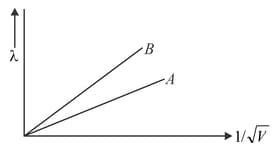de Broglie's Hypothesis
de Broglie's Hypothesis: Overview
This topic covers concepts such as de-broglie wave, and de-broglie wavelength.
Important Questions on de Broglie's Hypothesis
The energy of the electron, in the hydrogen atom, is known to be expressible in the form
sing this expression, which of the following statement is/are true?
(i) Electron in the hydrogen atom cannot have energy of .
(ii) Spacing between the lines (consecutive energy levels) within the given set of the observed hydrogen spectrum decreases as n increases.
For what kinetic energy of a proton, will the associated de Broglie wavelength be 16.5 nm?
For what kinetic energy of a neutron the associated de Broglie wavelength be ?
An particle and a proton are accelerated from rest by the same potential. The ratio of their de Broglie wavelengths would be:
An particle and a proton are accelerated from rest by the same potential. The ratio of their de Broglie wavelengths would be,
Two lines, A and B, in the plot given below show the variation of de Brogile wavelength, versus , where V is the accelerating potential difference, for two particles carrying the same charge. Which one of two represents a particle of smaller mass?

An -particle and a proton are accelerated from rest through the same potential difference V. Find the ratio of de-Broglie wavelengths associated with them.
An -particle and a proton are accelerated from rest through the same potential difference V. Find the ratio of de-Broglie wavelengths associated with them.
A proton and an -particle are accelerated from rest by and potentials, respectively. The ratio of their de-Broglie wavelength is :
The de Broglie wavelength of an electron having kinetic energy is . If the kinetic energy of electron becomes , then its de-Broglie wavelength will be:
The ratio of the de-Broglie wavelengths of proton and electron having same kinetic energy:
(Assume )
Proton and electron will have same de-Broglie wavelength when the ratio of their momentum is (assume, )
The de Broglie wavelength of a molecule in a gas at room temperature is . If the temperature of the gas is increased to , then the de Broglie wavelength of the same gas molecule becomes
The kinetic energy of an electron, particle and a proton are given as and respectively. The de-Broglie wavelength associated with electron particle and the proton are as follows:
If de-Broglie wavelength is when energy is (Kinetic energy). Find the wavelength at (Kinetic energy).
Find ratio of de-Broglie wavelength of a proton and an particle, when accelerated through a potential difference of and respectively.
Proton and electron have equal kinetic energy, the ratio of de-Broglie wavelength of proton and electron is . Find .
(Mass of proton is times mass of electron)
For an electron and a proton with same de-Broglie wavelength, the ratio of linear momentum is equal to:
Kinetic energy of electron, proton and a particle is given as and respectively, then which of the following gives the correct order of de-Broglie wavelengths of electron, proton and a particle
If the kinetic energy of a particle is increased by find the percentage change in its de Broglie wavelength .
